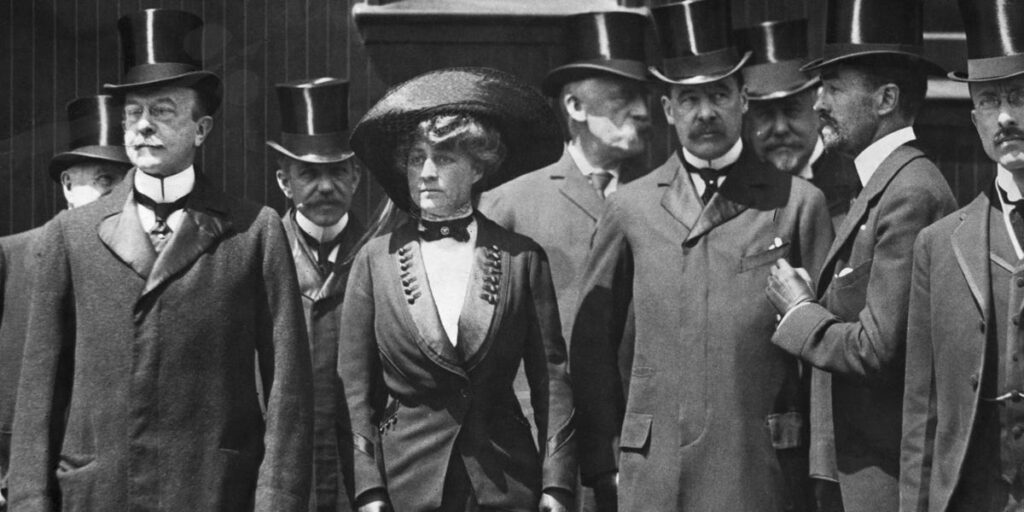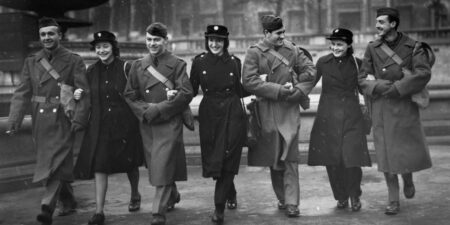Updated
X
Copy link
Impact Link
Save
Saved
Read in app
subscribers. Become an Insider
and start reading now.
Have an account? .
- In the late 1800s, tycoons amassed huge fortunes in America and weren’t shy about showing them off.
- They spent conspicuously, from fancy clothes to European mansions to lavish masked balls.
- The Gilded Age also featured an underbelly of corruption and inequality.
The adage goes that money can’t buy happiness, but during the Gilded Age, it certainly bought a lot.
From the end of the Civil War until President Theodore Roosevelt began to impose limitations on America’s wealthy tycoons at the turn of the 20th century, a select few grew enormously rich. Often, they were bankers or those who profited off a number of commercial industries, including railways, oil, and steel.
At the same time, the newly rich sought to spend. They wanted to be seen spending more than their rivals, and they wanted to be treated as equals by those with old money.
Here’s how the tycoons of the Gilded Age spent their fortunes.
In the years after the Civil War in 1865, a few Americans, including Andrew Carnegie, John Rockefeller, Cornelius Vanderbilt, and JP Morgan, began to make huge sums of money.
These wealthy figures were bankers or tycoons who controlled oil, railroads, steel, and other key industries.
By 1897, America’s 4,000 richest families — making up less than 1% of the country — had as much wealth as 11.6 million other families combined, Time magazine reported.
They didn’t just make fortunes — they spent fortunes, too. It was a period of conspicuous spending that Mark Twain dubbed the “Gilded Age.”
It wasn’t called “the golden age” for a reason. “Gilded” meant the glitz and glamour were covering something not as shiny: rampant inequality.
The term was coined by Mark Twain and Charles Dudley Warner with their 1873 satirical novel, “The Gilded Age: A Tale of Today.”
One of the defining features of the period was showing off.
The rich flaunted their wealth for everyone to see with the goal of one-upping each other.
With the goal of working their way into the upper echelons of society, those with self-made fortunes looked to how European royalty lived.
Gilded Age mansions, such as silver heiress Theresa “Tessie” Fair Oelrichs’ Rosecliff estate and coal tycoon Edward Julius Berwind’s mansion known as The Elms, were modeled after French palaces and chateaus.
There was a visible difference between old money families and the newly rich.
Across the country, especially in New York City, those with old money sought to keep their world to themselves, while the newly rich were busy building themselves extravagant mansions.
Alva and William K. Vanderbilt, who were considered “new money,” built a mansion called the “Petit Chateau” in New York City. Other elites thought it garish.
The mansion was made of white limestone — whereas brownstone was in fashion at the time — and occupied close to a block of Fifth Avenue.
It cost $3 million to build in 1882, the equivalent of around $98 million today, and was demolished in 1926, Vogue reported.
In HBO’s “The Gilded Age,” the central “new money” family, the Russells, are based on the Vanderbilt family.
Cornelius Vanderbilt II and his wife, Alice, built an even more ostentatious mansion on 57th Street in New York for about $3.375 million, the equivalent of more than $110 million today.
The Vanderbilts’ mansion, made of red brick and limestone, was nicknamed the “Buckingham Palace of Fifth Avenue.”
The mansion originally had about 50 rooms, but the couple bought neighboring townhouses, tore them down, and expanded the mansion until it had about 91 rooms, The Wall Street Journal reported.
It was later replaced by the Bergdorf Goodman department store.
Not too far away on 73rd Street, steel tycoon Charles M. Schwab built himself a mansion made of steel, limestone, and granite.
The mansion had 75 rooms, a bowling alley, a swimming pool, and three elevators.
Perhaps most impressively, Schwab had an organ concealed by a tapestry that was woven by 100 Flemish women who had come to the US for that sole purpose, The Wall Street Journal reported.
It was demolished in 1948 and replaced with an apartment building.
But the mansions weren’t restricted to New York City. In 1878, railroad mogul John Work Garrett bought his son Harrison and his family another famous mansion with 48 rooms in Baltimore.
The Garrett family displayed items and antiques they acquired on their worldwide travels, including German porcelain, Tiffany glass, and Japanese inro, The Washington Post reported.
Their library contained 8,000 volumes, including original books by Audubon and Shakespeare.
It also had a chandelier and a table with candelabras.
Building and buying mansions was only one way the newly wealthy would spend money in the Gilded Age. Shopping for clothes was another.
Every year, socialites would go to Europe to keep up with the latest fashions. The women shopped in Paris, while the men shopped in London.
They also hosted over-the-top parties.
Socialite Marion “Mamie” Graves Anthon Fish, who was married to American railroad tycoon Stuyvesant Fish, hosted a dinner party for her dog where she dressed him up in a $15,000 diamond collar, PBS reported.
Millionaire CKG Billings loved horses so much that his dinner party was held on horseback inside a fancy New York restaurant called Sherry’s.
Dinner trays were attached to the saddles, and Champagne was enjoyed through straws from bottles housed in saddlebags, The New York Times reported.
However, most dining took place in proper seats in the wealthy’s dining rooms or at high-end restaurants like Delmonico’s.
Delmonico’s is still in business in New York City — it has been since 1837, according to the restaurant’s website.
During this era, there was one diner who was famed for how much he could eat.
Diamond Jim Brady, who made his millions selling railroad supplies, reportedly started his day with pancakes, steaks, chops, eggs, muffins, grits, bread, fried potatoes, and orange juice.
Brady would have morning tea, afternoon tea, six or seven servings of dinner, and dessert, but there were varying accounts about how much he really ate.
In 2008, The New York Times found reports stating that doctors had said his stomach had become six times larger than normal.
One of the best-known socialites was Caroline Astor, whose famous “List of 400” consisted of guests from 25 socially acceptable families.
The list, which was co-authored with tastemaker Ward McAllister, also featured the exact number of people she could fit in her ballroom, Vogue reported.
Astor hosted parties in her ballroom, which was topped with a dome made of stained glass. Its walls were hung with about 100 paintings.
Like the era itself, Astor was later revealed to be less wealthy than people thought.
After she died, her goods were auctioned off and people discovered her dinnerware was gold-plated, not solid gold, Town and Country reported.
Society gatekeepers like Astor made social mobility difficult for the newly rich.
In 1883, Alva Vanderbilt, daughter-in-law of Cornelius Vanderbilt, threw a masked ball which cost about $250,000, or about $8 million today.
She invited 1,200 guests, but purposefully didn’t invite Caroline Astor’s daughter unless she came with her mother, according to the Museum of the City of New York.
Caroline Astor did attend as she’d hoped, strengthening Alva Vanderbilt’s place in society.
The ball was a huge success. Dinner wasn’t served until 2 a.m. and the dancing continued until dawn.
The newly rich displayed their fortunes by attending the opera, access to which was controlled by old-money families.
In New York, a group with inherited wealth controlled who could get tickets to the Academy of Music, an opera house, and made it impossible for others to see a show.
In 1883, a group of newly rich families banded together to open the Metropolitan Opera so they could see opera performed, as well.
Gilded Age tycoons did some good with their fortunes, funding museums, orchestras, and opera groups.
Industrialist Andrew Carnegie, who donated money to fund more than 2,500 libraries around the world, said if a rich man died rich, he “died disgraced.”
By the 1910s, the Gilded Age was coming to an end as the age of tycoons weakened and the underbelly of corruption was exposed.
Tycoons made their money at the expense of the working class. As newspapers exposed the underlying corruption that allowed an elite few to hoard enormous amounts of wealth, President Theodore Roosevelt imposed new limits on corporate power and established tax and political reforms.
It would take a few more years before the Gilded Age fully ended, but the days of ostentatious eating, spending, and partying were over.
Read the full article here
















